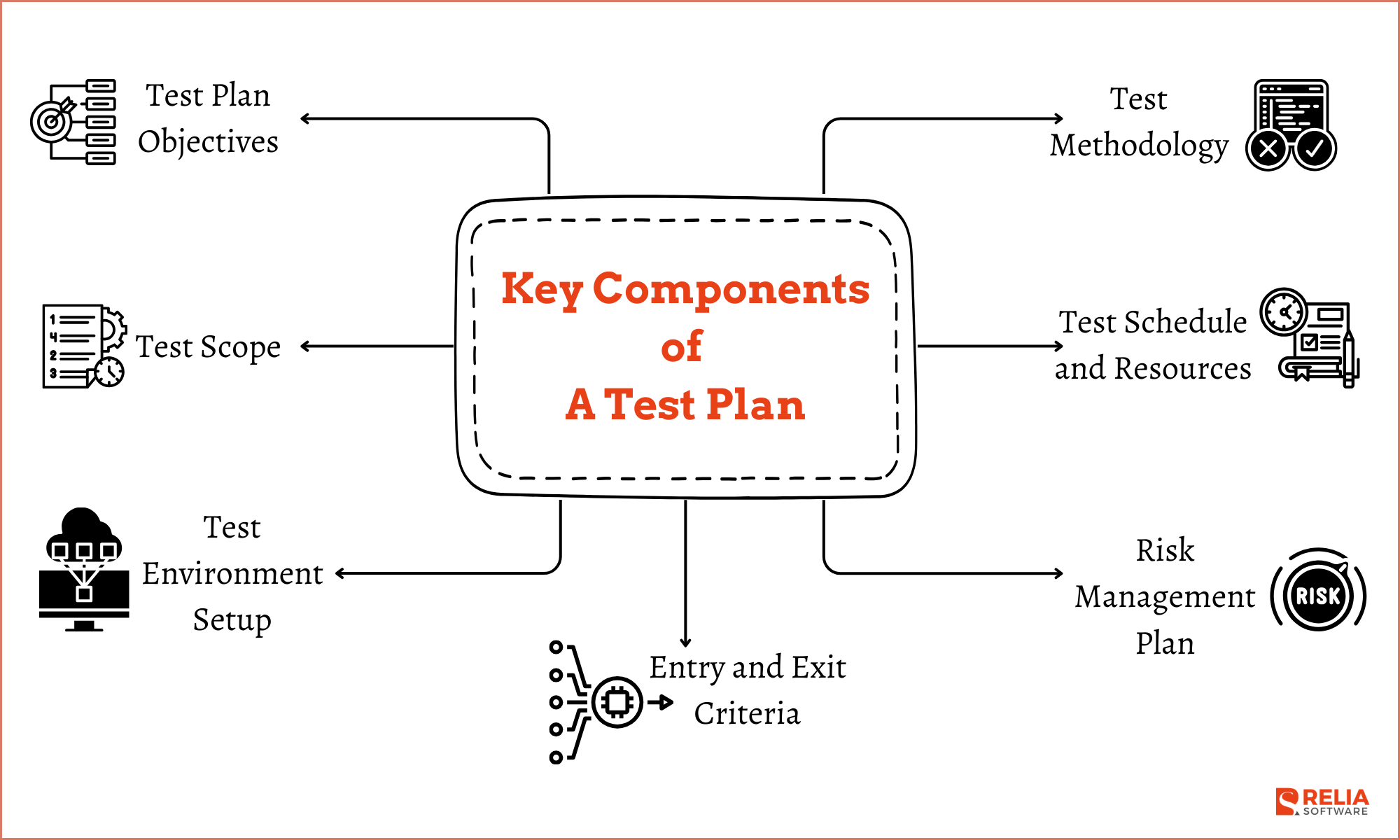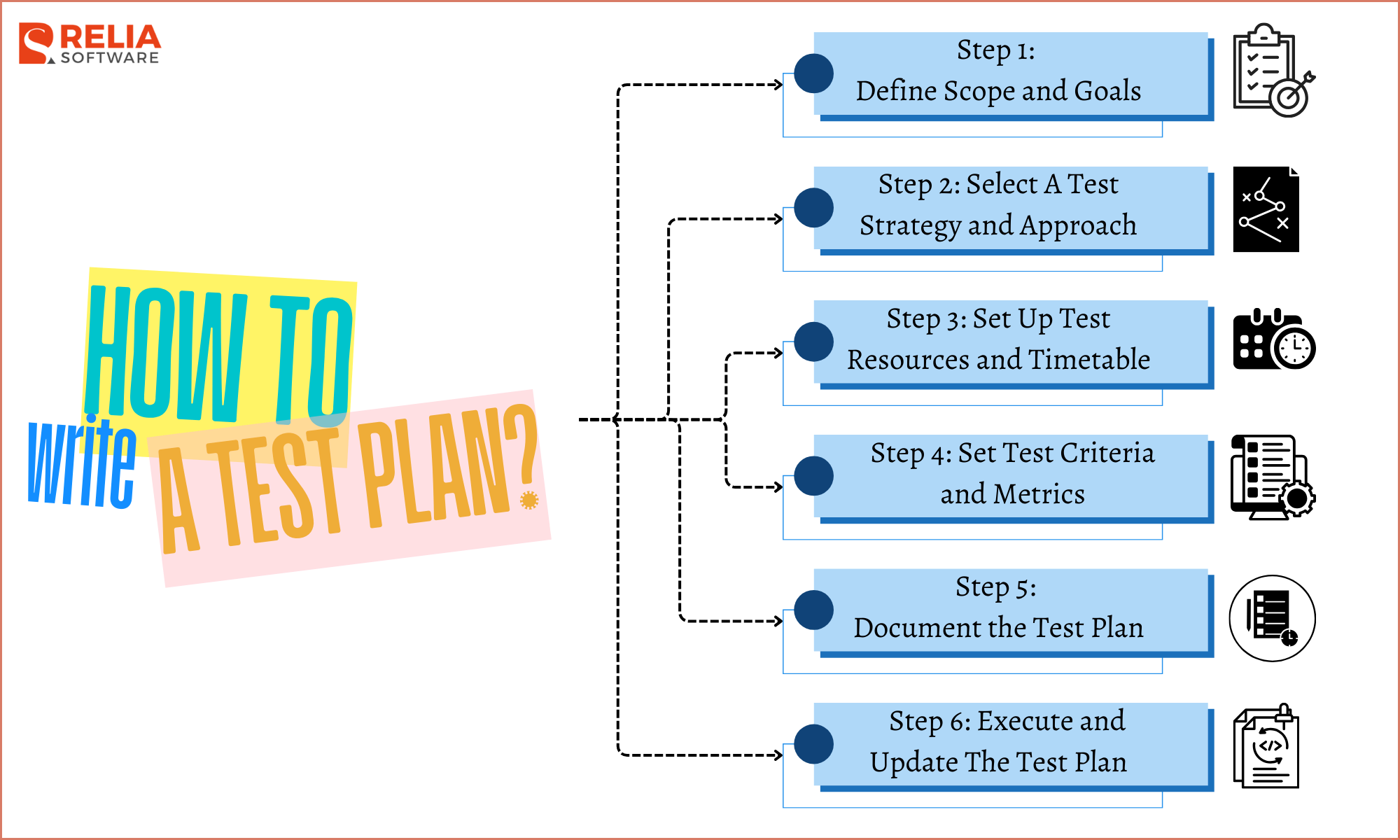In software development, a well-defined test plan is a critical tool for ensuring high-quality applications. The plan will simplify the process, anticipate issues, and promote clear communication between stakeholders.
This blog will guide you through the definition of a test plan in software testing, its key components, a guide to developing one, and its benefits as well as challenges.
>> Read more:
- Detailed Explanation of 7 Software Testing Principles
- What is Security Testing in Software Testing?
- AI in Software Testing: How It Works, Benefits & Challenges
- Difference between Verification and Validation in Software Testing
What is a Test Plan in Software Testing?
A test plan in software testing is a thorough document that specifies the testing goals, strategy, resources, and processes for a specific project. It acts as a roadmap ensuring clear testing objectives and efficient allocation of resources and schedules.
A well-written test plan ensures all stakeholders understand the testing objectives, schedules, and effort required. It also guarantees comprehensive testing of functionalities, UI elements, and other critical components, ultimately increasing testing accuracy and reducing the likelihood of problems throughout the application's lifespan.
Types of Test Plan
There are 3 types of test plans in software testing that you may need to clarify clearly.
Master Test Plan
This sort of test plan contains numerous test methodologies and levels of testing. It delves deeply into the design and management of testing at various test levels, providing a bird's-eye view of the key decisions taken, techniques employed, etc. It also provides a list of tests that must be run, test coverage, the relationship between different test levels, and so on.
Phase Test Plan
A phase test strategy focuses on a single phase of testing. It provides more details on the levels specified in the master testing plan. The phase test plan includes information not found in the master test plan, such as testing dates, benchmarks, activities, templates, and other details.
Specific Test Plan
This type of test plan is intended for certain forms of testing, primarily non-functional testing, such as plans for conducting performance or security tests.
Key Components of A Test Plan
A well-defined test plan includes the essential elements for effective software testing. Here are some key components you should include:
Test Plan Objectives
Every test plan starts with a clear purpose. It delves into specific objectives like identifying software defects, ensuring software quality meets user requirements, and measurably achieving these goals.
The test plan objectives can use the concept of SMART objectives (Specific, Measurable, Achievable, Relevant, and Time-bound) to emphasize the importance of setting focused and achievable testing goals.
Test Scope
These are the limits of what will be tested. It involves carefully choosing the specific functionalities and features to be tested, ensuring alignment with project needs.
Test Environment Setup
For thorough and reliable testing, you need to set up a specialized testing environment. This part has different types of testing environments, like development, staging, and production, and how to set up hardware, software, and network configurations to mimic real-world usage scenarios.
Entry and Exit Criteria
To start and end the testing phase correctly, you need clear and measurable criteria. Entry criteria are the conditions that must be met before testing can begin. Conditions for entry can be tools that are needed and ready, application needs to be made, and the test results. For instance, when using a model-based testing technique, the test basis is the entry criterion to use this technique.
Exit criteria are the goals that must be met for the testing phase to be considered complete. Conditions of exit are no big bugs, the passed tests, and test cases running. Examples of exit criteria can be the test basis, risk, functionality, supported configurations, and the software code that achieved a defined level of coverage or did not.
Test Methodology
It covers application testing types like functional, integration, and system testing. You will pick what type of testing to execute on each feature based on the application requirement. Due to potential variations in testing terminology, you should specify the testing methods you will employ to ensure clear communication and understanding among testers, developers, and managers.
Test Schedule and Resources
Making a realistic test schedule is important for managing everyone’s expectations and ensuring timely project completion. The schedule should consider factors like the project timeline, available testing tools, test case complexity, and the size of the testing team.
Risk Management Plan
Unexpected issues could arise during testing. This plan helps identify possible risks, severity, and mitigation strategies. You can make sure the testing process goes more smoothly and quickly by effectively finding and managing risks.

Key Components of A Test Plan (Source: Canva)
Who Needs A Test Plan?
A well-written test plan is important for a successful software development process. It offers significant advantages for the following stakeholders.
-
Developers: The test plan provides developers valuable insights into the scope and needs of testing. It helps them guess what tests will be run on their code and know the factors for successful testing.
-
QAs: Those make test cases and run them to find bugs and write down what they find. Planning tests help them come up with testing methods, decide how to use resources and keep track of how the testing process is going overall.
-
Product Managers: They use test plans to make smart choices about when to release products, how to allocate resources, and how the quality of the products is generally. It helps them plan release activities, figure out how the changes will affect customers, and make it easier for the development and testing teams to work together.
-
Business Analysts: They will make sure that all of the test cases are in line with the business standards at all stages, remaining focused on delivering value to end-users. They get a clear picture of how test cases fit in with real user needs through test planning.
-
Compliance Teams: This team can make sure that the testing methods follow the rules that regulators have already set.
-
Support Teams: They will talk to users about known problems, offer quick fixes, and help users find ways to get around them. Based on the test plans, the support team can figure out how to fix the possible problems or bugs found during testing.
How To Develop A Test Plan in Software Testing?
Here comes the 6-step process of developing a test plan for software testing.
Step 1: Define Scope and Goals
Define the test plan's scope and objectives before starting testing. The scope determines which software features, functions, and components are examined and omitted. The objectives explain the testing's expected outcomes and benefits based on company goals and user needs. You should also identify and manage testing risks, assumptions, and limits.
Step 2: Select A Test Strategy and Approach
This step will set the level of coverage, types of testing, quality requirements, and the roles and duties of the testing team throughout the process. The test strategy also specifies the test case design methods, data requirements, testing tools, and environment.
Step 3: Set Up Test Resources and Timetable
Allocate test resources and schedules to start the testing process. Testing requires a tester team, along with hardware, software, and licenses. The test schedule includes test stages, cycles, deliverables, and events, alongside their deadlines, milestones, and dependencies. These have to be prepared before the test starts.
Step 4: Set Test Criteria and Metrics
This phase helps evaluate testing quality and progress. Entry and exit criteria are test criteria that must be met before, during, and after testing. Defect, coverage, efficiency, and satisfaction metrics are test metrics that specify quantitative and qualitative indications for testing evaluation.
Step 5: Document the Test Plan
In this phase, we implement writing the test plan in a clear, concise, and easy-to-understand format. The test plan should include scope, objectives, strategy, approach, resources, schedule, criteria, and metrics. The stakeholders should confirm templates, formats, and terminology used in a project before finalizing the test strategy.
Step 6: Execute and Update The Test Plan
The test plan should be utilized as a reference and communication tool during the testing process. The test plan should be examined amended, and archived for future reference and improvement.
>> Read more: An Ultimate Guide to Different Test Case Design Techniques

Benefits & Challenges of Test Plan in Software Testing
Understanding the benefits and challenges of using a test plan is essential for planning an effective testing strategy.
Benefits
Stable Software
A well-designed test plan makes sure all key software parts are described and tested to avoid mistakes. Testers follow a test strategy to weigh and verify problems, situations, and functions to ensure the software stability.
Efficiency
Structured testing ensures efficient use of time and resources. A clear test plan prevents testers from repeating tasks and enables them to focus on the most relevant ones.
Effective Communication
Testing can clarify the process and align stakeholders. It makes stakeholders understand their product's behavior along with clarifying the approach and timescales for relevant parties.
Manage Risk
Risk is inherent in all projects. Test plans can help management consider time, resource, and compatibility constraints. These hazards can cause delays, costs, or project failure if ignored.
Progress Mark
A good test plan is a baseline for measuring progress. Although timing is crucial to any test plan, understanding test performance against expectations is also important. It will help you make the right decisions throughout the testing process.
Default Tracking
A dynamic test plan involves tracking defaults and prioritizing to fix them first. Then, it records issues and their resolutions for further improvement.
Historical Document
Test plans contribute to a complete record of the software testing life cycle. Project managers can record testing activities, decisions, and findings for future reference and product documentation.
Challenges
A thorough test plan has obvious benefits, but it is not an easy ride. Producing the correct paper takes time, planning, and experience. When creating your test plan, you may meet these typical difficulties:
Uncertain Requirements
Project stakeholders' requirements may differ for various reasons. Developers will struggle to create the appropriate testing strategy with incomplete or confusing requirements.
Demands Shift
Due to indecision or the stakeholders' confusion, the requirements change usually, which makes software developers adjust test strategies and cases to follow the update. It also needs transparent and efficient communication to keep the test strategy relevant and effective.
Testing Environment Complexity
Setting up and maintaining testing environments can be difficult, especially for complicated applications. Teams need to consider testing on diverse operating systems, platforms, and devices to ensure thorough coverage. In particular, poor testing environments can lead to issues like testing delays, erroneous bug reporting, and missing flaws.
Data Management
Testing requires accurate and dependable data. Complex application testing generates massive amounts of data that need to be accurately captured, analyzed, and interpreted. Inadequate data management can lead to inaccuracies and stall testing progress.
Reports and Feedback
Product managers must document errors and solutions throughout testing. Clear and concise testing reports are essential for developers, testers, and stakeholders to understand testing results and make informed decisions.
Test Automation
Test automation demands technical competence and high-quality software to maximize its benefits. Teams must write tests, report results, and maintain cases based on them. Without enough testing automation experience, they may face a steep learning curve.
>> Read more: Manual Testing vs Automation Testing: Which is Better?
Template Example of Test Plan in Software Testing
If you are still confused about the test plan structure, here is an example template of a test plan in software testing that you can reference.
|
Test Plan Title: Briefly describe the project and the testing scope. |
|
Introduction:
|
|
|
|
|
|
|
>> Read more:
- What is Automation Testing in Software Development?
- Top 6 Automation Testing Tools for Businesses
- Top 10 Best End-to-End Testing Tools and Frameworks
- End-To-End Testing Definition
- Testing Beyond Features: Unlock Non-Functional Testing (NFT)
- Mastering Functional Testing for Delivering Bug-Free Software
Conclusion
A clear test plan in software testing can get you high-quality software offered. It helps you find and fix problems early. Don't forget to update your plan as the project goes on to achieve optimal testing results.
If you are looking for a partner for software quality assurance & testing services, refer to Relia Software. With over a decade of experience in testing development, our highly qualified QA specialists will give you the best practices and cutting-edge testing methodologies for your apps.
>>> Follow and Contact Relia Software for more information!
- testing

